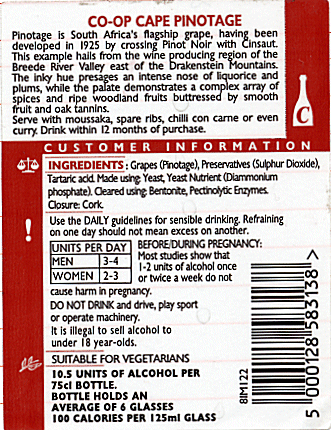D o you know what is in your wine? Unlike other foodstuffs, winemakers do not have to list ingredients on the label. Not only are they are not required to, but they are forbidden by law to do so.
This means Co-op supermarkets are lawbreakers, because their own label wines have detailed information about the contents of their bottles. They have gone ahead; fully aware that to do so is “in direct contradiction of existing legislation”.
The back label of Co-op’s Cape Pinotage reads
INGREDIENTS: Grapes (Pinotage), Preservative (Sulphur Dioxide), Tartaric acid. Made using: Yeast, Yeast Nutrient (Diammonium phosphate).
Cleared using: Bentonite, Pectinolytic Enzymes.
Closure: Cork
The Co-op says “Whilst we believe that alcoholic drinks should include an ingredients list on their labels, it's not quite as simple as it might first appear.” Not only is it illegal, but “some ingredients are used but are not present in the product as sold. Yeast and finings, for example, are vital in the manufacture but are not present in the final drink.” After consultation with consumers they decided “it would be helpful to give an indication of how the wine is made so that our customers are kept fully informed. This includes listing the ingredients, those only that we used to make the wine, but which do not end up in the final product, and the methods used to clear the wine (often of interest to vegetarians and vegans).”
How far to go is a moot point. The front label says ‘American Oak’, implying the wine has had some oak treatment. The otherwise informative back label doesn’t mention oak, and yet this is a flavouring most often remarked on by wine tasters. And has the wine been aged in oak barrels, or have they taken the cheaper option of suspending oak staves or chips in tanks?
This is a surprising lapse on a label that shows a considerable amount of information, including alcohol units and glasses per bottle and the number of calories in each of those glasses. What else is missing? It doesn’t tell us who made the wine. The 2002 vintage is Wine of Origin Breede River Valley, which covers Worcester, Swellendam and Robinson. It could come from the large Slanghoek winery in Rawsonville, or Rooiberg Winery in Robertson, or somewhere else.
But these are quibbles. The Co-op has pioneered consumer friendly wine labelling; they’ve deliberately ignored a nonsensical law and should be applauded.

The back label contains the following.
CO-OP CAPE PINOTAGE
Pinotage is South Africa’s flagship grape, having been developed in 1925 by crossing Pinot Noir with Cinsaut. This example hails from the wine producing region of the Breede River Valley east of the Drakenstein Mountains. The inky hue presages an intense nose of liquorice and plums, while the palate demonstrates a complex array of spices and ripe woodland fruits, buttressed by fruit and oak tannins.
Serve with moussaka, spare ribs, chilli con carne or even curry. Drink within 12 months of purchase.
CUSTOMER INFORMATION
INGREDIENTS: Grapes (Pinotage), Preservative (Sulphur Dioxide), Tartaric acid. Made using: Yeast, Yeast Nutrient (Diammonium phosphate).
Cleared using: Bentonite, Pectinolytic Enzymes.
Closure: Cork
Use the DAILY guidelines for sensible drinking. Refraining on one day should not mean excess on another.
UNITS PER DAY
MEN 3-4
WOMEN 2-3
BEFORE/DURING PREGNANCY
Most studies show that 1-2 units of alcohol once or twice a week do not cause harm in pregnancy.
DO NOT DRINK and drive, play sport or operate machinery.
It is illegal to sell alcohol to under 18 year-olds.
SUITABLE FOR VEGETARIANS
10.5 UNITS OF ALCOHOL PER 75cl BOTTLE.
BOTTLE HOLDS AN AVERAGE OF 6 GLASSES
100 CALORIES PER 125ml GLASS
There is also a wine style indicator – a silhouette of a bottle with the letter C and a bar code.
The label is 1.5 by 2.25 inches (63x82mm )
peter@winelabels.org


